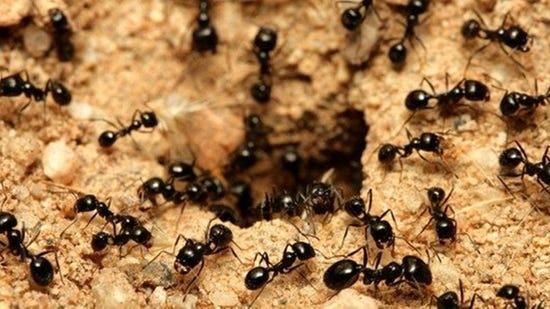
ANTS
ABOUT ANTS AND ANT CONTROL
ANTS FAMILY FORMICIDAE
The ants are one of the most familiar and important group of insects. In 1985 Taylor and Brown catalogued the Australian fauna and placed them in nine subfamilies, with 95 genera and an estimate total of 4000 species. The principal characteristic of ants is the waist. It is composed of usually one or two knobs (which are the first one or two segments of the abdomen) rather than the single petiole of the hymnopterans. The antennae have a distinctive elbow, with the scape nearly as lone as the segments past the elbow, and the mandibles are prominent.
Ants live in colonies made up of several castes and subcastes: winged males, winged females and several subcastes of workers. Colonies usually have hundreds to several thousand individuals, though the range is less than 100 to more than a million. Winged males and females appear only at times suitable for mass mating flights. The males die after mating and the females shed their wings and usually start a new colony, or sometimes join an existing one. To begin a colony the female lays a small number of eggs and then feeds the larvae to maturity.
These first workers then take over the functions of nest building and look after this first queen whose only remaining function is to lay eggs.
The worker subcastes include the worker minors which perform nest building, nursery care and food foraging,; workers with large heads called soldiers which defend the nest; and intermediate forms in different species. Some species have a sophisticated subcaste called repletes which act as storage vessels for the colony nectar supply.
Ant nests are usually in the ground, but can be in trees and even among silk-joined leaves in the green tree ant, Oecophylla smaragdina, which dominates in the tropics. The best known Australian ants are aggressive, stinging bull ants, in the large endemic genus Myrmecia. Among the ground nesting ants, the meat ants, Iridomyrmex, are well known red and black foragers which dominate the more arid landscapes. One of the largest genera is Polyrhachis, which includes metallic species and the ‘golden-bum’ ants.
Ants have a varied diet, with predators and scavengers, plant eaters, fungus eaters and other specializations or combinations of these. Some species of plants, especially in the tropics, have a special relationship with a particular ant species. The so-called ‘ant-plants’ have special chambers colonized by ants and sometimes even provide food for them in return for protection from herbivores. Another ant relationship involves specialized species in eight other insect orders called myrmecophiles. These live within the nests of ants either as predators or scavengers, or are actively encouraged by the ants as they produce sweet secretions favoured as ant food. Some ants actually ‘farm’ aphids, scale insects and some butterfly larvae for this purpose.
The following hymenopteran groups, the sphecid wasps (formerly superfamily Sphecoidea) and the bees (superfamily Apoidea), are now commonly regarded as one group under the umbrella of the superfamily Apoidea).
Source: A field guide to insects in Australia - third edition - Paul Zborowski and Ross Storey - New Holand publishers








